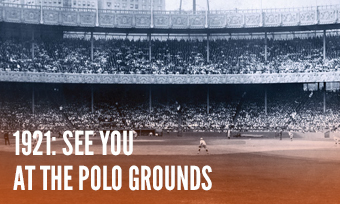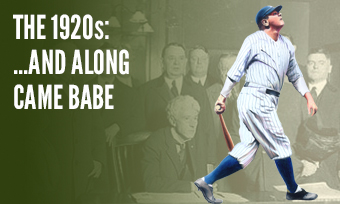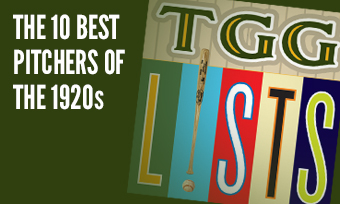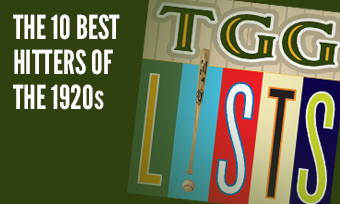The Yearly Reader
Leaders and Honors, 1921
Our list of baseball’s top 10 hitters and pitchers in both the American League and National League for the 1921 baseball season, as well as the awards and honors given to the game’s top achievers of the year.
The National League’s Top 10 Hitters, 1921
Bold type in brick red indicates league leader.
1. Rogers Hornsby, St. Louis
Key Numbers: 154 games, .397 average, 131 runs, 235 hits, 44 doubles, 18 triples, 21 home runs, 126 RBIs, .458 on-base percentage, .639 slugging percentage.
Hornsby slumped in the final weeks to miss becoming the NL’s first .400 hitter since 1899; he’d get a few more shots in later years.
2. Frankie Frisch, New York
Key Numbers: .341 average, 121 runs, 211 hits, 31 doubles, 17 triples, 8 home runs, 100 RBIs, 49 stolen bases.
In a Giants lineup loaded with explosive performances, none was perhaps more nitro than Frisch in his first full season.
3. Austin McHenry, St. Louis
Key Numbers: .350 average, 201 hits, 37 doubles, 8 triples, 17 home runs, 102 RBIs.
A breakout star, McHenry’s promising path to stardom would be cut tragically short a year later by a deadly brain tumor.
4. Jack Fournier, St. Louis
Key Numbers: .343 average, 103 runs, 197 hits, 27 doubles, 9 triples, 16 home runs, 86 RBIs, 8 hit-by-pitches.
Hornsby’s content Cardinals teammate was settling quite nicely into the live ball era, jumping his home run total from three the year before.
5. Ross Youngs, New York
Key Numbers: .327 average, 24 doubles, 16 triples, 102 RBIs, 70 walks, 21 stolen bases.
The exciting Giants outfielder, never to be confused for a slugger even in live times, surpassed 100 RBIs for the only time in his career.
6. George Kelly, New York
Key Numbers: .308 average, 95 runs, 181 hits, 42 doubles, 9 triples, 23 home runs, 122 RBIs.
The home run total for the man nicknamed High Pockets was all that separated Rogers Hornsby (above) from a triple crown.
7. Irish Meusel, Philadelphia-New York
Key Numbers: .343 average, 96 runs, 201 hits, 33 doubles, 14 triples, 14 home runs, 87 RBIs.
Though he accumulated better numbers in Philadelphia than New York (hitting .353 with 12 home runs in 84 games for the Phillies), Meusel was happy to trade stats for wins as the Giants sprung to a NL pennant.
8. Dave Bancroft, New York
Key Numbers: .318 average, 121 runs, 193 runs, 26 doubles, 15 triples, 66 walks.
One of the Giants’ many recent steals from the depths of the second division, Bancroft was beginning to equal his graceful defensive talent with that of his bat.
9. Edd Roush, Cincinnati
Key Numbers: 112 games, .352 average, 27 doubles, 12 triples, 71 RBIs, 19 stolen bases.
A series of leg injuries curtailed Roush’s participation, but he still turned in a career-high batting average.
10. Zack Wheat, Brooklyn
Key Numbers: .320 average, 182 hits, 31 doubles, 10 triples, 14 home runs, 85 RBIs.
All of this from the Brooklyn fan favorite who the Robins wanted to trade, because owner Charles Ebbets felt he’d been around “too long”; a contract dispute was behind it all.
The American League’s Top 10 Hitters, 1921
1. Babe Ruth, Boston
Key Numbers: .376 average, 158 runs, 172 hits, 36 doubles, 9 triples, 54 home runs, 135 RBIs, 150 walks, .532 on-base percentage, .847 slugging percentage.
The second chapter of the Bambino’s monster act showed that he was still a good 10 years ahead of everyone else.
2. Harry Heilmann, Detroit
Key Numbers: .394 average, 114 runs, 237 hits, 43 doubles, 14 triples, 19 home runs, 139 RBIs.
Heilmann barely fell below .400, but he did outhit his tutor, first-year Tigers manager Ty Cobb, to become the AL’s first right-handed batting leader since 1905.
3. Ty Cobb, Detroit
Key Numbers: 128 games, .389 average, 124 runs, 197 hits, 37 doubles, 16 triples, 12 home runs, 101 RBIs, 22 stolen bases.
Live-ball fever caught up to the Georgia Peach, whose home run totals entered double-digit territory for the first time—but it didn’t compromise his batting average, which placed him second in the AL behind Harry Heilmann.
4. George Sisler, St. Louis
Key Numbers: .371 average, 125 runs, 216 hits, 38 doubles, 18 triples, 12 home runs, 104 RBIs, 35 stolen bases.
A .371 average only comes off as okay when you have someone like Sisler hitting .407 the year before and .420 the year after.
5. Ken Williams, St. Louis
Key Numbers: .347 average, 115 runs, 190 hits, 31 doubles, 24 home runs, 117 RBIs, 74 walks, 20 stolen bases.
Playing in just his second full major league season at age 31, Williams late-bloomed into the emerging class of Babe Ruth wannabes—but a pretty good one at that.
6. Bob Meusel, New York
Key Numbers: .318 average, 104 runs, 190 hits, 40 doubles, 16 triples, 24 home runs, 135 RBIs, 88 strikeouts.
Were it not for Ruth’s presence, sophomore Yankee star Meusel might have been considered the AL’s premier slugger.
7. Bobby Veach, Detroit
Key Numbers: .338 average, 110 runs, 207 hits, 43 doubles, 13 triples, 16 home runs, 128 RBIs.
Veach joined Ty Cobb and Harry Heilmann to give the game one of its most potent outfields (combined average: .372).
8. Tris Speaker, Cleveland
Key Numbers: .362 average, 107 runs, 52 doubles, 14 triples, 75 RBIs, 68 walks.
Spoke dangled with the .400 mark as he did numerous times throughout his career, hanging above it as late as July 9 before cooling off.
9. Jack Tobin, St. Louis
Key Numbers: .352 average, 671 at-bats, 132 runs, 236 hits, 31 doubles, 18 triples, 8 home runs.
It’s hard to believe that Tobin’s 132 runs and 236 hits didn’t lead the league, but welcome to the live-ball era.
10. Elmer Smith, Cleveland
Key Numbers: .290 average, 98 runs, 28 doubles, 9 triples, 16 home runs, 85 RBIs, 56 walks.
Smith set a career high in home runs a year before a trade to a devolving Red Sox team that left him fuming.
The National League’s Top 10 Pitchers, 1921
1. Burleigh Grimes, Brooklyn
Key Numbers: 2.83 ERA, 22 wins, 13 losses, 302.1 innings, 30 complete games, 136 strikeouts, 28 caught stealing/picked off.
In a year where the grandfathered spitballers ruled, Grimes was happily all wet while nabbing his long strikeout crown.
2. Eppa Rixey, Cincinnati
Key Numbers: 2.78 ERA, 19 wins, 18 losses, 301 innings.
A year after losing 22 at Philadelphia, the 6’5” Rixey was happy to skim over .500 with the Reds—allowing a NL record-low one home run over 300 innings.
3. Whitey Glazner, Pittsburgh
Key Numbers: 2.77 ERA, 14 wins, 5 losses, .737 win percentage.
A year of sole success for the 27-year-old rookie, who was 27-43 in four other big-league campaigns.
4. Wilbur Cooper, Pittsburgh
Key Numbers: 3.25 ERA, 22 wins, 14 losses, 38 starts, 327 innings, 27 grounded into double plays.
On the other hand, Cooper continued to prove that he was the ace for the long term in Pittsburgh, ramping up to become the year’s busiest NL workhorse.
5. Johnny Morrison, Pittsburgh
Key Numbers: 2.88 ERA, 9 wins, 7 losses, 3 shutouts.
A Pittsburgh rookie like Glazner (above), Morrison differed in that he had a few more surprises in the years to come; he also likely became one of a handful of pitchers ever to lead a league in shutouts despite not throwing enough innings to qualify for an ERA title.
6. Bill Doak, St. Louis
Key Numbers: 2.59 ERA, 15 wins, 6 losses.
Doak soaked up the wet ball and won his second ERA title, seven years after his first.
7. Joe Oeschger, Boston
Key Numbers: 3.52 ERA, 20 wins, 14 losses, 46 appearances, 299 innings, 97 walks, 15 hit-by-pitches.
Historically grounded with awful teams, Oeschger soared toward fleeting success before crashing back to reality.
8. Babe Adams, Pittsburgh
Key Numbers: 2.64 ERA, 14 wins, 5 losses, .737 win percentage, 160 innings, 16 walks.
A year away from turning 40, Adams turned in his last strong effort, leading the NL for the third straight season in opposing on-base percentage.
9. Jesse Barnes, New York
Key Numbers: 3.10 ERA, 15 wins, 9 losses, 6 saves, 258.2 innings.
Three Giants teammates won as many or more games than Barnes—but none of them were as efficient as he sported a decidedly lower ERA.
10. Dolf Luque, Cincinnati
Key Numbers: 3.38 ERA, 17 wins, 19 losses, 3 shutouts, 304 innings.
There was no place like home for the Cuban-born Luque, who was 11-6 at then-spacious Crosley Field with a 2.59 ERA; he was 6-13 with a 4.50 mark on the road.
The American League’s Top 10 Pitchers, 1921
1. Red Faber, Chicago
Key Numbers: 2.48 ERA, 25 wins, 15 losses, 32 complete games, 330.2 innings.
The remnants of the post-Black Sox White Sox would had looked ever more tattered had it not been for Faber; the Chicago staff ERA was 5.78 without him.
2. Carl Mays, New York
Key Numbers: 3.05 ERA, 27 wins, 9 losses, .750 win percentage, 7 saves, 49 appearances, 336.2 innings.
Only a hardened soul like Mays could channel all the anger aimed at him a year after fatally beaning Ray Chapman, and reign as baseball’s best non-spitballer.
3. Sad Sam Jones, Boston
Key Numbers: 3.22 ERA, 23 wins, 16 losses, 5 shutouts, 298.2 innings.
Sad in name only, Jones was mostly happy on the road—where he was 15-3 as opposed to an 8-13 mark at Fenway Park.
4. Waite Hoyt, New York
Key Numbers: 3.09 ERA, 19 wins, 13 losses, 282.1 innings.
The 21-year-old breakout pitcher—a former Red Sock, of course—threw at his best when it mattered most; six of his 19 wins came against second-place Cleveland.
5. George Mogridge, Washington
Key Numbers: 3.00 ERA, 18 wins, 14 losses, 288 innings.
With Walter Johnson struggling through a relative mid-career crisis, Mogridge developed as a temporary ace at Washington.
6. Stan Coveleski, Cleveland
Key Numbers: 3.37 ERA, 23 wins, 13 losses, 40 starts, 315 innings.
The Indians ace became only the second Cleveland pitcher (Addie Joss, 1905-08) to win 20-plus games in four consecutive seasons.
7. Urban Shocker, St. Louis
Key Numbers: 3.55 ERA, 27 wins, 12 losses, 47 appearances, 326.2 innings.
The spitballer set a still-standing Browns/Orioles season record for victories, with 14 of them coming in just the last two months alone.
8. Bullet Joe Bush, Boston
Key Numbers: 3.50 ERA, 16 wins, 9 losses.
Like Sad Sam Jones (above), Bush committed the Red Sox sin of being too good; he’d be a Yankee in 1922.
9. Walter Johnson, Washington
Key Numbers: 3.51 ERA, 17 wins, 14 losses, 264 innings, 143 strikeouts.
Rebounding from an injury-marred 8-10 campaign the year before, the Big Train posted his highest ERA yet—thank you, live ball—but did lead the AL in strikeouts for 10th time.
10. Eric Erickson, Washington
Key Numbers: 3.62 ERA, 8 wins, 10 losses.
The majors’ second Swedish native (after Charlie Bold), Erickson never had a winning record over nine years in the bigs but makes the list because so few people managed to reach base against him relative to other AL pitchers.









